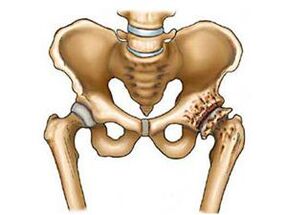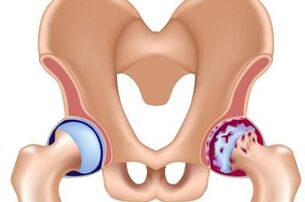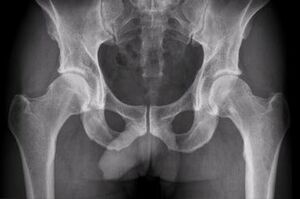
Arthrosis of the hip joint (coxarthrosis) is a chronic disease, gradually progressive, in the absence of adequate and timely treatment, can result in complete loss of movement. The ending suggests that not an inflammatory process, but a degenerative process prevails.
The symptoms of this disease vary depending on the stage. At first, it is an almost imperceptible discomfort that occurs when walking and exercising. Perhaps a manifestation in the form of mild pain in the thigh region, which disappears at rest. In that case, the pain can be felt not only in the thigh, but also in the groin or knee.
As a rule, coxarthrosis is a process that has been going on for many years, characterized by a gradual change of cartilage with subsequent deformation of the bones and loss of joint functionality. It mainly affects people after the age of 40, but there are also very young patients.
Causes of the occurrence
Why does arthrosis of the hip joint occur and what is it? The causes of coxarthrosis can be different, but the condition is always the same. It all starts with a change in the articular cartilage, which gets thinner and loses the ability to absorb loads. The body compensates for the stratification of the cartilaginous tissue by the formation of bony protuberances along the edge of the joint surfaces, which leads to deformation of the joints and bones to varying degrees.
The main causes of this joint disease:
- Injuries. This cause may not be a major injury, but in many cases the development of the disease is influenced by chronic microtrauma that contribute to cracking and thinning of the cartilage. They also affect the rupture of the joint capsule, leading to the accumulation of many injuries. Often, repetitive microtrauma is a precursor to the onset of this disease.
- Excessive loads, leading to systematic microtrauma as well as joint damage. Most of the time, it occurs in people who perform heavy physical work or in professional athletes. In this case, treatment without changes in lifestyle or exercise limitations is also ineffective and is often accompanied by relapses.
- Hereditary predisposition. This includes abnormalities in the development of the femoral head itself, underdevelopment of the elements of the joint, and so on. In this case, the so-called dysplastic arthrosis of the hip joint occurs.
- Diseases. For example, arthritis, if not treated properly, can progress to osteoarthritis over time. This is due to the fact that, during arthritis, the properties of cartilage tissue change and blood circulation is impaired. This gradually leads to the development of a degenerative process.
- Excess. Excess body weight, even when walking, exerts a load on the joints that exceeds its limits of physiological strength.
Depending on the cause of the disease and its pathogenesis, there are 2 main types of arthrosis of the hip joint.

- Primary Coxarthrosis. In this case, the disease develops very slowly and begins with a violation of the blood supply to the tissues. The reasons for the development of this type of arthrosis are rooted in metabolic disorders, more common in people over 50 years old. Primary arthrosis of the hip joint is the most commonly diagnosed.
- Secondary Coxarthrosis. In this case, the disease develops in the context of systemic inflammatory lesions of many joints in the body. The inflammation can be infectious and autoimmune in nature.
In the early stage of coxarthrosis, patients are concerned only with a little pain or discomfort in the joint area. Often, these signs are ignored, causing the disease to progress.
Symptoms of arthrosis of the hip joint
Coxarthrosis of the hip joint, the symptoms of which cannot be ignored, can lead to serious consequences. There are several main signs of the disease, which depend on the stage of the disease:
- Pain in the joint area is the most obvious symptom by which any disease of the hip can be presumed. The intensity and nature of the sensations usually depends on the stage.
- Limitation of limb mobility is also a symptom of coxarthrosis. The initial phase is characterized by a feeling of “stiffness” in the joint, which passes after some effort.
- Weakening of the thigh muscles can be seen in the second stage of the disease, reaching the third stage of complete atrophy.
- Changes in leg length due to pelvic deformity are characteristic of "advanced" osteoarthritis.
- Claudication or change in gait is a very likely sign of bone deformity.
- A distinct compression in the joint is not always a sign of arthrosis. Usually taken into account when other symptoms are present.
The main symptom of coxarthrosis is pain, whose nature, duration, location and intensity depend on the stage of the disease.
1 degree hip joint arthrosis
This stage of the disease is characterized by pain in the joint and hips, sometimes in the knee, arising after physical exertion and decreasing after rest. Joint mobility is not limited and there are no gait disturbances.
1st degree coxarthrosis is the initial stage of the disease, starting the treatment from which it is still possible to interrupt the process of destruction and deformation of the joint and preserve its functions completely. But, unfortunately, many feel that it is not necessary to see a doctor because of mild joint pain as the disease progresses.
2nd degree arthrosis of the hip joint

It seems clearer - the intensity of the pain increases, it occurs not only after exercise, but also at rest, there is a limitation of motor functions. In particular, coxarthrosis is characterized by difficulty in pronation (internal rotation of the hip) and abduction, and contracture is formed.
The X-ray examination shows a narrowing of the joint space and the appearance of bone growths on the surfaces. The acetabulum and the femoral head are deformed. The thigh muscles begin to atrophy on the side of the injury, and the pain syndrome spreads below, capturing both the knee joint and the groin region (it is important to understand that this will not be accompanied by degenerative changes in the knee joint).
Grade 3 hip arthrosis
The signs of the disease are pronounced and permanent. The pain syndrome appears at night. When walking, the patient uses support. The leg and thigh muscles gradually atrophy, and a sick person's sick leg becomes much shorter.
Often, in the 3rd degree, the joint space completely disappears and the joints grow together in a single bone structure, this is demonstrated by photography. As a result, complete joint immobility occurs.
X-rays show extensive bony growths of the acetabulum roof and femoral head, a marked narrowing of the joint space. The femoral neck is significantly enlarged and shortened.
Diagnosis
Before figuring out how to treat osteoarthritis of the hip joint, it is necessary to make a correct diagnosis. If coxarthrosis is suspected, the person will be referred for a biochemical blood test - in the presence of a disease, patients have a slight increase in ESR, globulins, immunoglobulins and seromucoid.
The next step in detecting arthrosis is an X-ray photo. It will reveal:
- cartilage ossification,
- bone growth at the edge of the cartilage,
- decreasing the distance between the joints,
- thickening of bone tissue under the cartilage.
Unfortunately, the radiographic photo does not allow the visualization of the joint capsule and cartilage itself, if it is necessary to obtain information about these soft tissues, the patient will be referred for tomography.
Treatment of arthrosis of the hip joint
When diagnosed with osteoarthritis of the hip joint, treatment will depend directly on the stage at which the disease is. The general treatment regime provides for the achievement of the following objectives:
- eliminates pain and discomfort in the painful joint area;
- adjust the nutrition of intra-articular cartilage and start the process of its restoration;
- eliminate intra-articular fluid deficiency;
- activates microcirculation in the tissues of the joint;
- eliminates increased load on the hip joint;
- strengthens the muscles that surround, protect and support the joint;
- to prevent deformity and increase mobility in the hip joint.
All of this can only be achieved with the help of an integrated approach, which should include not only drug therapy, but also lifestyle changes to eliminate the risk factors for coxarthrosis.

- In the third stage of the disease, treatment involves surgery, during which the joint is replaced by an endoprosthesis, while part of the prosthesis is implanted in the femur and part - in the pelvic bone. The operation is quite complicated, time-consuming and requires a long period of rehabilitation.
- In grades I and II of osteoarthritis of the hip joint, treatment is performed without surgery. Used: non-steroidal anti-inflammatory drugs, muscle relaxants, chondroprotectants, vasodilators, hormonal steroids, topical medications - ointments, lotions, compresses.
All of these drugs are prescribed exclusively by the attending physician. Some are effective when injecting directly into the affected joint area. These injections can only be administered by qualified medical personnel. Therefore, self-medication is strictly not recommended.
Non-medication methods
In addition to the use of drugs, doctors also recommend non-drug methods to deal with the disease. These include the following treatments for this disease:
- physiotherapy; massage
- ;
- joint creation;
- diet.
Physiotherapy for osteoarthritis includes the following treatments:
- magnetic therapy;
- UHF and ultrasound therapy;
- aeroionic and electrotherapy;
- inductotherm;
- phototherapy;
- application of laser technology.
All of these methods can only be used to improve the blood supply to the joints and relieve spasms.
Medical therapy
The combined treatment of hip arthrosis involves the appointment of the following groups of drugs:

- Nonsteroidal anti-inflammatory drugs, they all relieve pain, relieve inflammation, but do not restore cartilage tissue.
- Chondroprotectors. Nutritional cartilage preparations. Speed up your recovery. Important in phase 1. 2 of the treatment of arthrosis. In grade 3 of the disease, the cartilage is already destroyed, these drugs will be useless. It takes a long time to take medicine, take several courses.
- Muscle relaxantseliminate muscle spasms in the area of diseased joints, improve blood supply to tissues.
- Polishes and creams. Healing ointments are ways to relieve the condition of a sick person, but they do not contribute to complete recovery. Heating polishes work well. They irritate the skin's receptors and thus reduce pain. Warming ointments also work to restore increased blood circulation in the tissues and muscles around the affected joint.
- Steroid injections into the joint cavity, injections of these drugs are prescribed to relieve exacerbation of the disease and eliminate severe pain.
- Vasodilatorsdilate the vessels in and around the joint cavity, thus improving the supply of nutrients necessary for tissue repair.
You don't have to rely on folk remedies. But some healers recommend tincture of lemon, garlic or celery root to treat joints and bones.
Massage in the treatment of coxarthrosis
In the case of deforming arthrosis of the hip joint, massage treatment gives good results. Massage for coxarthrosis is a very effective and useful method. It is advisable that the massage is performed by a good specialist and as often as possible.
Its action aims to improve blood circulation, strengthen muscles, relieve painful spasms, swelling and muscle tension, as well as increase diastasis between the articulating elements of the joint.
In the absence of a professional masseuse, the massage can be done by you. The osteoarthritis massage can be performed either manually or with the help of various massage devices and even a jet of water (hydrokinesia therapy).
Gymnastics
The treatment of osteoarthritis of the hip joint by physical education consists of achieving two objectives: to increase the mobility of the legs and to prevent muscle atrophy. All standard exercise therapy complexes for coxarthrosis also have a general strengthening character and a positive effect on the entire body.
The gymnastic exercise complex is prescribed by a specialist. The first physical therapy sessions must be supervised by a doctor. It will show you how to perform each movement correctly and also monitor the proper load on your hip joints.
Diet
Main recommendations:
- Prefer porridge in water.
- Eat enough animal protein: fish (except salted), poultry, beef.
- Eat at least 5 servings of vegetables a day (one serving is 100 grams, can be used as a side dish).
- Dairy products are needed: cottage cheese, yogurt, fermented milk.
- Eliminate alcohol, coffee, strong black tea.
- Eliminate sweet, starchy foods.
- Eat small meals frequently.
The diet will reduce stress on the hip joints and provide everything necessary for tissue repair.




























